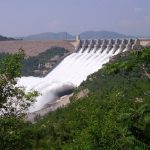ISLAMABAD: The government on Wednesday signed a Rs442 billion contract with a joint venture of China Power and Frontier Works Organisation (FWO) for the construction of the Diamer-Bhasha dam.
The Chinese state-run firm holds 70 per cent and the FWO, a commercial arm of the Armed Forces of Pakistan, 30pc share in the consortium. The contract covers construction of a diversion system, main dam, access bridge and the 21MW Tangir hydropower project.
The eight million acre feet (MAF) reservoir with 272-metre height will be the tallest roller compact concrete (RCC) dam in the world. It will have a spillway, 14 gates and five outlets for flushing out silt. The diversion system involves two tunnels and a diversion canal — all three having one kilometre length each. The bridge — a box girder structure — under the contract will be constructed downstream of the dam structure while the 21MW power plant will be built to meet energy requirements of the project during construction.
Prime Minister Imran Khan was briefed on the progress of the project a couple of days ago. The construction work on dam will begin in a couple of weeks.
Diamer-Bhasha dam project chief executive officer Amir Bashir Chaudhry and authorised representative of China Power Yang Jiandu signed the agreement on behalf of the Water and Power Development Authority (Wapda) and the joint venture, respectively. Water Resources Minister Faisal Vawda, Chinese Ambassador Yao Jing, Water Resources Secretary Mohammad Ashraf, Wapda chairman retired Lt Gen Muzammil Hussain, Pakistan Army engineer-in-chief Lt Gen Moazzam Ejaz and FWO director general Maj Gen Kamal Azfar attended the signing ceremony.
The Wapda chairman expressed the hope that the Diamer-Bhasha dam would be completed as per the timelines to cope with the increasing water and electricity requirements of the country. The dam project with a total financial outlay of about Rs1,406.5bn would be completed in 2028, he said.
The total financial outlay includes land acquisition and resettlement, confidence building measures for social uplift of the local people, construction of dam and power houses.
Gen Hussain said the project would have a gross storage capacity of 8.1 MAF and power generation capacity of 4,500MW, with an annual generation of 18.1bn units. However, the electromechanical and power generation project would be taken up separately at a later stage.
Wapda has already awarded a Rs27.182bn contract for dam’s consultancy services to Diamer-Bhasha Consultants Group (DBCG). The consultancy agreement includes construction design, construction supervision and contract administration of the dam project.
The DBCG joint venture comprises 12 top-ranked national and foreign consulting firms — Nespak (Pakistan), Associate Consulting Engineers (Pakistan), Mott MacDonald Pakistan, Poyry (Switzerland), Montgomery Watson and Harza (MWH) International-Stantec (USA), Dolsar Engineering (Turkey), Mott McDonald International (England), China Water Resources Beifang Investigation, Design and Research Company (China), Mirza Associates Engineering Services (Pakistan), Al-Kasib Group of Engineering Services (Pakistan), Development Management Consultant (Pakistan) and MWH Pakistan, with Nespak as the lead firm. These firms have a vast experience of providing consultancy services for mega water projects the world over.
The Council of Common Interests (CCI) had approved the project for construction in 2010, but it suffered delays because of international lending agencies which remained associated with the project but later backtracked because of opposition from India. The government has already spent about Rs170bn on the project since then on land acquisition and other expenses. In view of the lenders’ resistance, it was decided about four years ago to divide the multi-purpose project into two major components — Rs650bn worth of dam project to be constructed with the public sector funds and Rs750bn worth of power project most probably to be developed in independent power producer (IPP) mode at a later stage.
The core project development (dam structure) alone is estimated to cost almost Rs270bn. The project offers a very attractive internal economic return of 15.7pc even at a 12pc discount rate, according to project documents.
The project is designed to serve as the main storage dam of the country, besides Mangla and Tarbela dams, and its storage would be helpful for alleviating flood losses. The dam will have a 6.4 MAF usable water storage capacity.
The project is estimated to help alleviate acute irrigation shortage in the Indus basin irrigation system caused by progressive siltation of the existing reservoirs, besides substantially contributing to reduce intensity, quantum and duration of floods and reduce magnitude and frequency of floods in the River Indus downstream.
The project will also have trickledown effects on all sectors of the economy by accelerating development and creating job opportunities, besides improving availability of water and clean energy. The completion of the dam would increase the country’s storage capacity from 30 to 48 days and make power generation facilities an attractive future investment by the private sector to add 4,500MW of additional electricity to the national grid.





